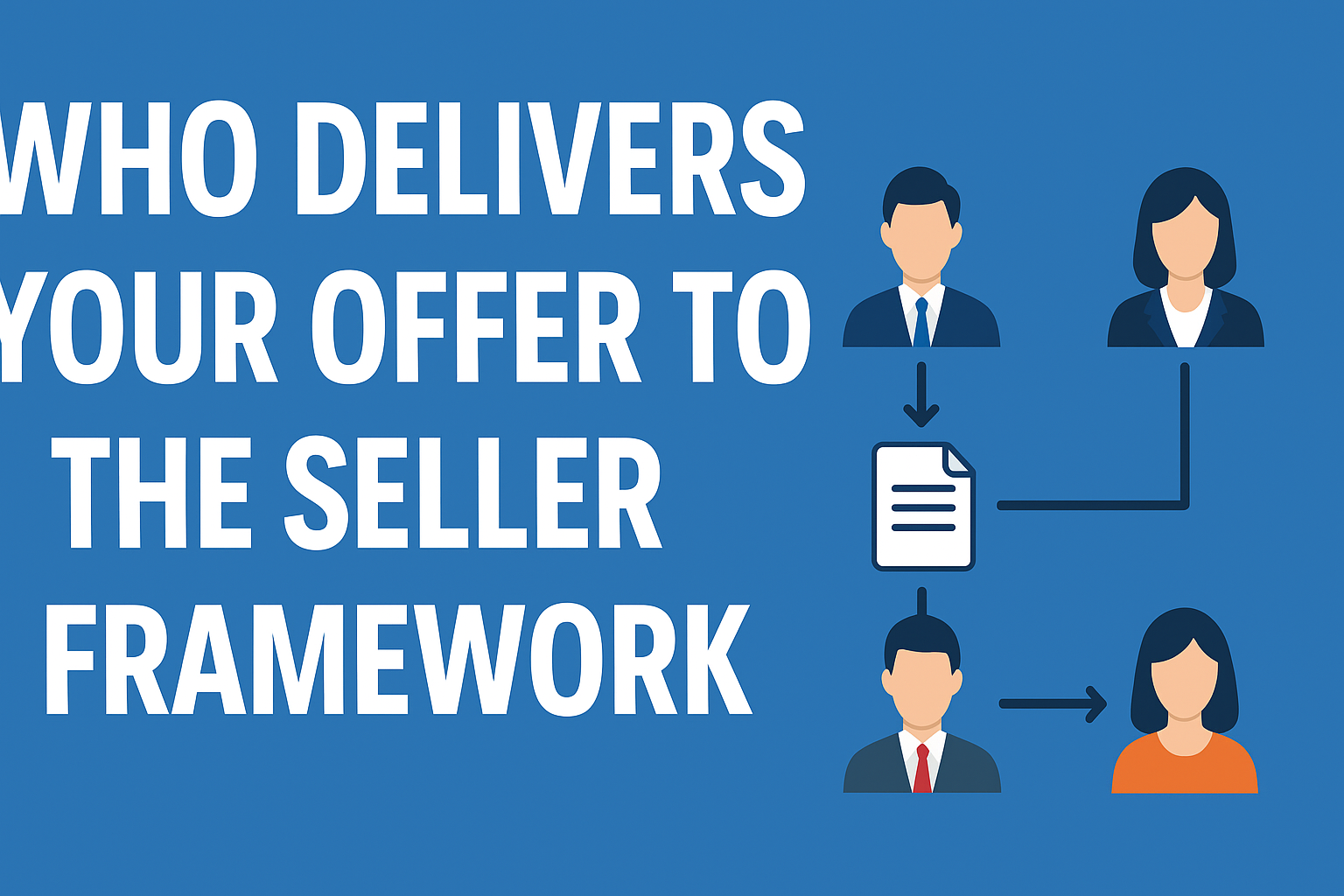Who Delivers Your Offer to the Seller Framework: Everything You Need to Know

When entering the real estate market as a buyer, one of the most overlooked yet crucial aspects of the process is how your offer actually reaches the seller. Many buyers ask the same question: who delivers your offer to the seller framework? While it may sound like a small detail, the delivery framework plays a significant role in how your offer is perceived, how negotiations unfold, and whether your deal moves forward smoothly.
In this comprehensive guide, we’ll break down the entire framework of delivering an offer to a seller, step by step. We’ll also explore the responsibilities of different parties involved, why the process matters, and how buyers can ensure their offer is presented in the strongest possible light.
Understanding Who Delivers Your Offer to the Seller Framework
The framework of delivering an offer refers to the sequence of people and processes through which a buyer’s offer reaches the seller. At first glance, it might seem straightforward—simply hand the offer to the seller. However, in professional real estate transactions, there is usually a structured path that ensures legality, professionalism, and fairness.
The standard framework looks like this:
-
Buyer prepares the offer with guidance from their real estate agent.
-
Buyer’s Agent submits the offer on behalf of the buyer.
-
Seller’s Agent (Listing Agent) receives the offer and reviews it for accuracy and completeness.
-
Seller finally receives the offer for review and decision-making.
So, when you ask “who delivers your offer to the seller framework,” the most accurate answer is your buyer’s agent delivers it through the seller’s agent to the seller. This system exists to keep the process fair and efficient, while reducing direct conflict between buyers and sellers.
The Role of the Buyer’s Agent in Delivering Offers
The buyer’s agent plays the most important role in this framework. Their responsibilities include:
-
Preparing the Offer: Drafting all documents, including purchase agreements, disclosures, and contingencies.
-
Submitting the Offer: Delivering it directly to the seller’s agent via secure methods such as email, e-signature platforms, or in some cases, in person.
-
Explaining the Offer: Highlighting the strengths of the buyer’s terms, such as financial readiness, closing timeline, or reduced contingencies.
-
Acting as a Negotiator: Standing between the buyer and seller to clarify terms and manage counteroffers.
The buyer’s agent ensures the seller sees not just numbers on paper but also the seriousness and reliability of the buyer.
The Role of the Seller’s Agent in the Framework
Once the offer is submitted, the seller’s agent takes over as the messenger and advisor to the seller. Their job includes:
-
Reviewing the Offer: Checking for missing information or potential red flags.
-
Presenting the Offer: Clearly explaining the buyer’s terms to the seller in a professional manner.
-
Advising the Seller: Offering insight into whether the offer is strong, fair, or risky.
-
Facilitating Communication: Relaying the seller’s response—whether it’s an acceptance, rejection, or counteroffer—back to the buyer’s agent.
This ensures the seller makes an informed decision without confusion or misinterpretation.
Direct Buyer-to-Seller Delivery: When Does It Happen?
Although less common, there are scenarios where the buyer delivers an offer directly to the seller. This happens primarily in:
-
For Sale By Owner (FSBO) transactions, where no real estate agents are involved.
-
Off-Market Deals, where buyers and sellers negotiate privately.
-
Small Local Markets, where buyers and sellers may know each other personally.
While this method may seem faster, it often introduces problems. Direct negotiations can become emotional, and the lack of professional oversight may lead to miscommunication or legal issues. That’s why the structured framework involving agents is usually preferred.
Why the Framework of Delivery Matters
The delivery method is not just a technicality—it can influence the seller’s perception and decision. Here’s why the framework is so important:
-
Professionalism: An offer delivered by an agent looks more credible and serious than a casual email or conversation.
-
Clarity: Agents ensure every clause, condition, and timeline is explained correctly.
-
Negotiation Strategy: A skilled agent can frame your offer to emphasize its strengths, such as fewer contingencies or strong financing.
-
Legal Protection: Real estate contracts involve legal obligations. Delivery through agents ensures compliance with state laws and protects both sides.
-
Efficiency: Offers are delivered quickly and securely, which is vital in competitive markets where timing can make or break a deal.
Step-by-Step Guide to Who Delivers Your Offer to the Seller Framework
To better understand the process, let’s look at the steps in detail:
Step 1: Drafting the Offer
The buyer and their agent draft the purchase agreement. This includes the offer price, earnest money deposit, financing terms, closing date, and contingencies.
Step 2: Submission by Buyer’s Agent
The buyer’s agent delivers the offer to the seller’s agent. Delivery is typically electronic but may also be in person for an added touch of professionalism.
Step 3: Review by Seller’s Agent
The listing agent carefully reviews the offer, checking for missing signatures, unclear terms, or inconsistencies.
Step 4: Presentation to Seller
The seller’s agent formally presents the offer to the seller. They highlight both strengths and weaknesses while comparing it to other offers, if applicable.
Step 5: Seller’s Decision
The seller chooses to accept, reject, or counter the offer. Their response is then communicated back through the same framework.
This structured flow ensures transparency and fairness throughout the negotiation process.
Common Mistakes in the Delivery Process
Even though the framework is designed to be smooth, mistakes still happen. Some of the most common include:
-
Incomplete Paperwork: Missing addendums or unsigned documents can delay or invalidate an offer.
-
Poor Communication: Misunderstandings between agents can create unnecessary tension.
-
Direct Delivery Without Agents: Skipping professionals often leads to emotional conflict or overlooked details.
-
Missed Deadlines: Offers that are not delivered on time may lose out to competitors.
Avoiding these mistakes is key to keeping your offer strong and competitive.
Tips for Buyers to Strengthen Their Offer Delivery
If you want your offer to stand out in the delivery framework, here are some strategies:
-
Work with an Experienced Agent: A skilled agent knows how to present your offer persuasively.
-
Include a Personal Touch: Some buyers include a letter explaining why they love the home, which can humanize the offer.
-
Be Prompt: Submitting an offer quickly can give you an edge in hot markets.
-
Ensure Accuracy: Double-check all documents before submission to avoid delays.
-
Show Financial Strength: Pre-approval letters or proof of funds demonstrate that you’re a serious buyer.
Read also: Gabby Pitso – The Inspiring Story of Resilience, Leadership, and Positive Change
Final Thoughts on Who Delivers Your Offer to the Seller Framework
The question of who delivers your offer to the seller framework may seem simple, but the answer reveals an entire system designed to keep real estate transactions smooth, professional, and fair.
In most cases, your buyer’s agent delivers the offer to the seller’s agent, who then presents it to the seller. This chain of communication ensures clarity, professionalism, and efficiency. While direct delivery can happen in certain situations, relying on agents is almost always the safer and more effective path.
For buyers, understanding this framework is crucial. It empowers you to work effectively with your agent, avoid mistakes, and increase your chances of having your offer accepted.
Buying a home is one of the biggest investments you’ll ever make, and every detail matters—including how your offer is delivered.



